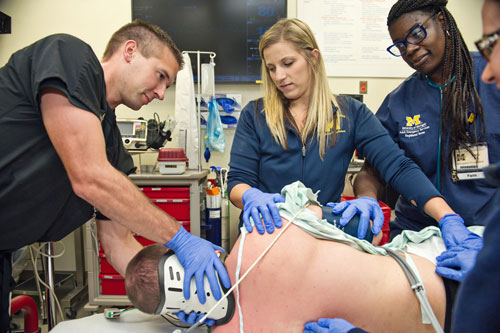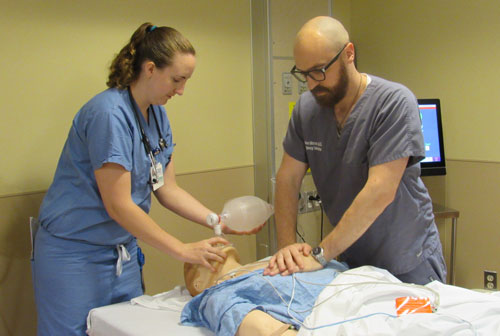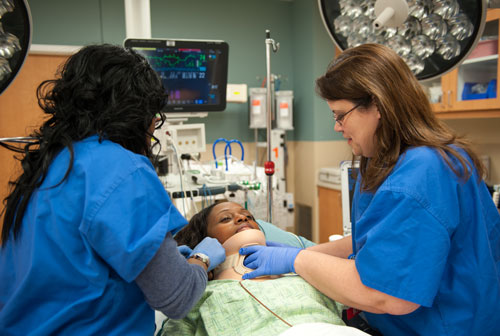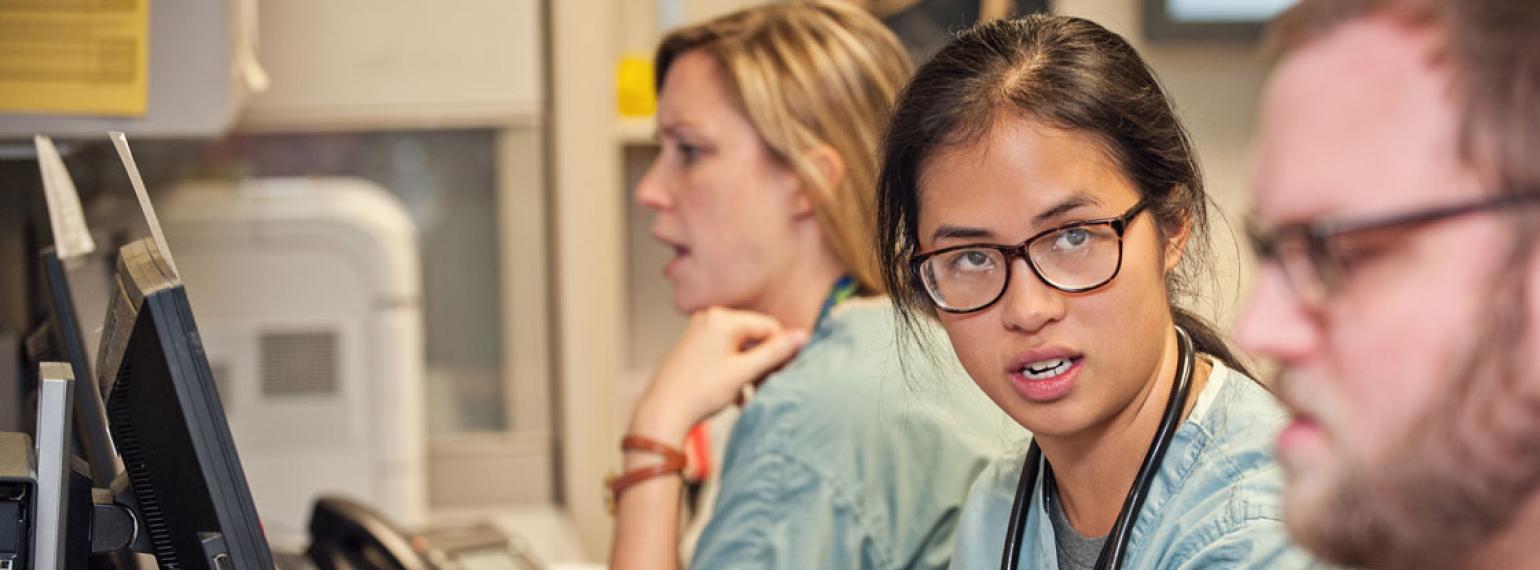Our program is designed to immerse residents in the full spectrum of emergency medicine practice settings. Our long-standing partnerships with St. Joseph Mercy Hospital and Hurley Medical Center give you integrated access to three high-volume, high-acuity hospitals.
Our training sites balance and complement each other, offering a range of perspectives and experiences in environments that differ in patient populations and resources. This broad exposure includes:
- Working with a mix of hospitalists, consultants, fellow residents and community physicians in a variety of health care models.
- Experience with two of the most widely used EMRs.
- Training in aspects of psychiatric emergency medicine, including at U-M’s psychiatric ER.
- Access to a wide range of cases, from rare and complex pathology and advanced stages of common pathology to high-acuity trauma and critical care medicine.
This diversity in experience will prepare you to confidently function and lead any type of emergency department when you complete the program.
“Our faculty are amazing at all three sites. They’re all different at each site, so you learn different ways of practicing emergency medicine.” — Sarah Tehranisa, M.D., EM4
Residents rotate through each training site for the same amount of time over the course of our 48-month program, however not necessarily in the same order. You can expect to spend more concentrated time at each site during the first two years of the program to help acclimate you to the inner workings of each department, and then a more blended experience in the upper years, potentially working shifts at each site within the same week.
The total time residents spend at each site over the 48-month program roughly breaks down as follows:
- 40% = University Hospital at Michigan Medicine
- 40% = Trinity Health - Ann Arbor
- 20% = Hurley Medical Center
Training Site Highlights
The Academic University Hospital
University Hospital at Michigan Medicine

We take care of high-acuity, high-complexity patients with the support of top-tier specialists and facilities in an environment of patient- and family-centered care. Michigan Medicine is home to a Level 1 adult and pediatric trauma and burn center and the Survival Flight aeromedical unit.
- 86-bed emergency department with an annual volume over 100,000 visits.
- Average of 1,450 trauma burn patients admitted each year.
- Pediatric emergency department and trauma center at Mott Children’s & Von Voigtlander Women’s Hospitals includes 31 exam rooms and two trauma bays.
- More than 26,000 annual pediatric patient emergency department visits.
- University Hospital is part of a huge medical complex that operates 1,000 patient beds.
- Home to the Michigan Center for Integrative Research in Critical Care (MCIRCC), a multidisciplinary research hub to innovate and improve care for critically ill and injured patients; and to the Great Lakes Emergency Medical Services for Children Research Network (GLEMSCRN), which is a research node of the Pediatric Emergency Care Applied Research Network (PECARN).
- Residents spend one shift per month in the Emergency Critical Care Center (EC3), one of the first in the country to provide critical care services in the emergency department as quickly and efficiently as possible.
The Community Teaching Hospital
Trinity Health - Ann Arbor Hospital

This nonprofit community hospital provides compassionate care for patients in a high-volume environment. This is a Level 1 adult trauma center. Residents gain experience practicing in a high-resource environment that allows for efficient patient care, disposition, and prompt follow-up as needed.
- 537-bed community teaching hospital located 5 miles east of Michigan Medicine with a 2016 volume of 88,000 visits.
- 65-bed emergency department and Certified Stroke Center includes specific areas for pediatrics, seniors, observation, and a split-flow model with rapid treatment area.
- More than 1,200 trauma admissions annually.
- More than 85,000 ER visits per year (including pediatric emergencies).
- A high-performing operations model, with ample opportunities for residents to get involved in quality improvement projects.
The Safety-Net Hospital
Hurley Medical Center

Hurley Medical Center is a safety-net medical center that’s committed to serving the surrounding region. A Level 1 trauma center, Hurley sees a high proportion of penetrating trauma (approximately 20%). Residents rotate here for exposure to front-line emergency medicine, including trauma resuscitation and stabilization, as well as advanced stages of common pathology, including DKA and severe COPD. The unique patient population — Flint sits at the juxtaposition of areas that are both highly urban and rural in a region challenged by socioeconomic depression — rounds out residents’ clinical exposure. The staff and department here model a community-focused care paradigm with multiple unique systematic approaches to serve the needs of their patients.
- 443-bed public teaching hospital located in Flint, Michigan.
- New 76-bed Emergency Department.
- The region’s only Level 1 Trauma Center and only burn unit, neonatal intensive care unit, pediatric intensive care unit and pediatric emergency department; residents gain experience in primary management of initial presentation of illness, but also receive transfers from the northern lower peninsula of Michigan.
- More than 100,000 annual visits to the ED.
“Being a patient advocate is really a part of emergency medicine and sometimes that means finding ways to make things happen for people who don’t have resources. The problems that we are trying to solve are not always medical ones. We deal with a lot of social determinants of health, which are equally as important to the welfare of our patients as blood sugar levels or prescribing the right antibiotic.” — Laura Hopson, M.D., Director of the Emergency Medicine Residency Program

